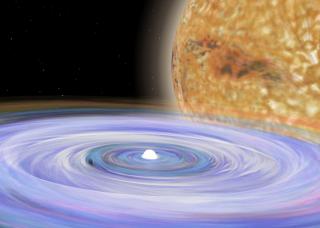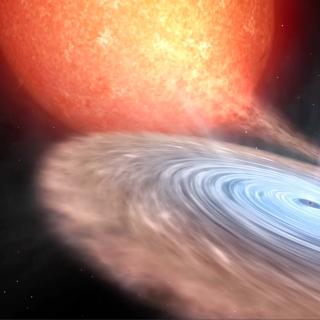Bibcode
Gomez, Sebastian; Torres, Manuel A. P.; Jonker, Peter G.; Kostrzewa-Rutkowska, Zuzanna; van Grunsven, Theo F. J.; Udalski, Andrzej; Hynes, Robert I.; Heinke, Craig O.; Maccarone, Thomas J.; Salinas, Ricardo; Strader, Jay
Referencia bibliográfica
Monthly Notices of the Royal Astronomical Society
Fecha de publicación:
3
2021
Número de citas
6
Número de citas referidas
6
Descripción
We present modelling of the long-term optical light and radial velocity curves of the binary stellar system CXOGBS J175553.2-281633, first detected in X-rays in the Chandra Galactic Bulge Survey. We analysed 7 yr of optical I-band photometry from Optical Gravitational Lensing Experiment and found long-term variations from year to year. These long-term variations can most likely be explained with by either variations in the luminosity of the accretion disc or a spotted secondary star. The phased light curve has a sinusoidal shape, which we interpret as being due to ellipsoidal modulations. We improve the orbital period to be P = 10.34488 ± 0.00006 h with a time of inferior conjunction of the secondary star T0 = HJD 2455260.8204 ± 0.0008. Moreover, we collected 37 spectra over 6 non-consecutive nights. The spectra show evidence for an evolved K7 secondary donor star, from which we obtain a semi-amplitude for the radial velocity curve of K2 = 161 ± 6 km s-1. Using the light-curve synthesis code XRBINARY, we derive the most likely orbital inclination for the binary of i = 63.0 ± 0.7 deg, a primary mass of M1 = 0.83 ± 0.06 M☉, consistent with a white dwarf accretor, and a secondary donor mass of M2 = 0.65 ± 0.07 M☉, consistent with the spectral classification. Therefore, we identify the source as a long orbital period cataclysmic variable star.
Proyectos relacionados

Estrellas Binarias
El estudio de las estrellas binarias es una parte esencial de la astrofísica estelar. Una gran parte de las estrellas de nuestra Galaxia y de otras galaxias se ha formado en sistemas binarios o múltiples, por lo que entender la estructura y evolución de estos sistemas es importante desde el punto de vista estelar y galáctico. Un aspecto en el que
Pablo
Rodríguez Gil

Agujeros negros, estrellas de neutrones, enanas blancas y su entorno local
Los agujeros negros y estrellas de neutrones en binarias de rayos-X son laboratorios únicos para explorar la física de estos objetos compactos. No solo permiten confirmar la existencia de agujeros negros de origen estelar a través de mediciones dinámicas de sus masas, sino que también permiten investigar el comportamiento de la materia y la
Montserrat
Armas Padilla